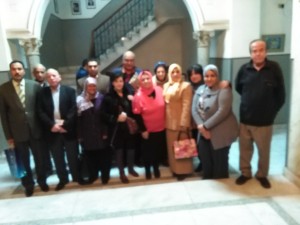Mohamed Nabil interviews Sharif El Shafei
Ahram Weekly 22 April 2009
The latest work by Egyptian poet Sherif El-Shafie is part of a large poetic project entitled The Complete Works of a Robot. For poetry readers it is a stone thrown into still water, and has been referred to by critics and intellectuals from Egypt and the Arab world as a highly original piece of work with a catchy content and artistic format. The poems represent a great change in recent Arabic poetry.
Since the first part of this project, "Searching for Nirmana with Intelligent Fingers", was published in Cairo last July it has received dozens of reviews in leading Arab newspapers.
With this collection, his fourth collection of poems, El-Shafie, 37, breaks new ground in that it is wholly narrated by a rebellious robot launched into the various paths of life and spheres of the universe with an intrinsic courage and freedom. The robot pays no attention to and even ridicules the radio waves that remotely "control his mechanical movement and path". This is an innovative robot that not only breaks away from the rules of the herd and opposes the laws that turn man into machine, but rebels against the economic, political, military, social and scientific innovations of his age; innovations that have enclosed man within a dark tunnel.
What is it that has motivated the robot to carry out this "artistic assault" on life?
"It is real life itself that has pushed him to attempt to search for it, sense its physics with the fingers and detect the essence of the soul which has not yet completely vanished," says El-Shafie, who also works in the media field.
El-Shafie is known for his adventures in the world of poetry: he is the author of the longest poem in modern Arabic poetry, entitled: "Colours Tremble Covetously", which came out in 1,035 pages.
El-Shafie's collection of poems are: "Between the Two of Them, Time Gets Rusty", 1994, "All by Himself, He Listens to the Concerto of Chemistry", 1996, and "Colours Tremble Covetously", 1999.
Also published by El-Shafie is a study on the role of place in the works of Naguib Mahfouz, under the title of "The Popular Districts in the Novels of Naguib Mahfouz, between Reality and Innovation", in 2006.
"The contaminated air in his room forced him to open the 'window' improve the ventilation; the 'window' can be a real one overlooking a view and detecting things in a direct way, and it can be jumped from too. It can also be an electronic window used to search electronically for Nirmana and her spectra," he explains.
The robot has decided on unprecedented withdrawal, or, in other words, initiate a risky adventure, the outcome of which cannot be measured. He has decided to withdraw from the mechanised and extensively disciplined universal room that is valid for a mechanically and digitally polluted life with calculated dimensions, but which is still a non-airy room where the soul can find no joy.
Moving from a fake, geometrical life that is parallel in nature to the essence of death, to a hypothetical and chaotic one, the robot can search for his distinct humanity and be free to chase his hypothetical Nirmana with her varied names and forms, in the existence of which he is the only believer.
What justifies this exhausting journey at this particular juncture? According to El-Shafie, "Matters have become increasingly cruel in the way man is stripped of his humanity, and in the way his will is effaced and his ability to take decisions is depleted.
"The principle of polarisation has become deeply rooted, while privacy and identity have plummeted to the ground."
"Man, in fact, has become a subjugated machine, while the compelling force is blind machines. The funny thing is that politicians, economists and people of wisdom are concerned about the depletion of the world's energies and are looking for alternative sources of energy, ironically enough, in a world that has basically run out of its spiritual power." He nods his head in agreement with his own words.
So it seems that the innovative robot poet, who has forsaken the submissive and tamed herd, is, in the first place, looking for an energy that is certain to have run out. It is the spiritual energy of his depleted soul that he is looking for, and if he finds it he will later on be able to search for other things.
The end of the book, however, suggests a return to where the robot began.
"In reality, he is back at the point where he has started, without finding either Nirmana or his depleted, 'lost' self. However, he is not back for nothing, since he has already come to realise his individuality and privacy. He has moved against the norms and programmes, and drifted away from the remote control held by a compelling power, and from the supremacy of the discipline; any discipline."
Consequently, El-Shafie adds, he has been able to detect the shame of an age fully drowned in materialism, machinery and technology, and has laid his hands on the main economic, political, military, social and scientific innovations that have led humanity to that desperate destiny, where the individual has no place to survive in the midst of the turmoil of smashing the masses, and where all sorts of things -- new births, education, enlightenment, production and consumption and murder -- are based on calculations, even calculations that are excessively arithmetical.
In this sense, the journey can be seen as an end in itself. "That tiring search in itself is of great value and is a call for rebellion and the testing of alternatives, particularly when there is nothing that necessitates caution. I mean, because the kind of life available to us is fake, mummified, and clinically dead and imprisoned in a sterile, universal room, it is therefore quite lovely that Nirmana's sweet virus of rebellion should intrude into such a life."
Nirmana has come from a strange world to lead our robot friend to the unknown; she leads the game from behind the scene. The robot has accepted only the desires of Nirmana because she is the only one who can control him. This is explained in one paragraph: 'Why have I accepted to be easily controlled by Nirmana? Maybe it is because she was enthusiastic about managing me from inside!"
So, is it man or machine that wins in the end?
"For the first part, the battle might seem to have been won by the machine, since the robot here is the hero in some sense. However, it is man, in reality, who is victorious as the robot is simply one who rebels against the rules and programmes that control him, and a deviant of the mechanic life. In the end, the 'lost' man for whom the robot is searching is the real hero, not the robot.
"My real dream is that poetry becomes, once again, a basic daily meal for the readers on the condition that the poet totally eliminates the inner distance within him and writes simply and, thus, the distance between him and the readers will vanish."
Is it immigration, or perhaps isolation, that created this work? El-Shafie, who has made his home in Saudi Arabia, continues: "It is important to bear in mind that immigration is not the physical absence from one's home country, but rather man's loss of his humanity, even though he is in his own country. It pleases me a lot to conclude with that stanza from 'Laughing Gases', the second part of The Complete Works of a Robot :
The stranger who crosses the road
Does not need a white stick,
Nor a trained dog;
He needs the roads to have welcoming and tender eyes."



